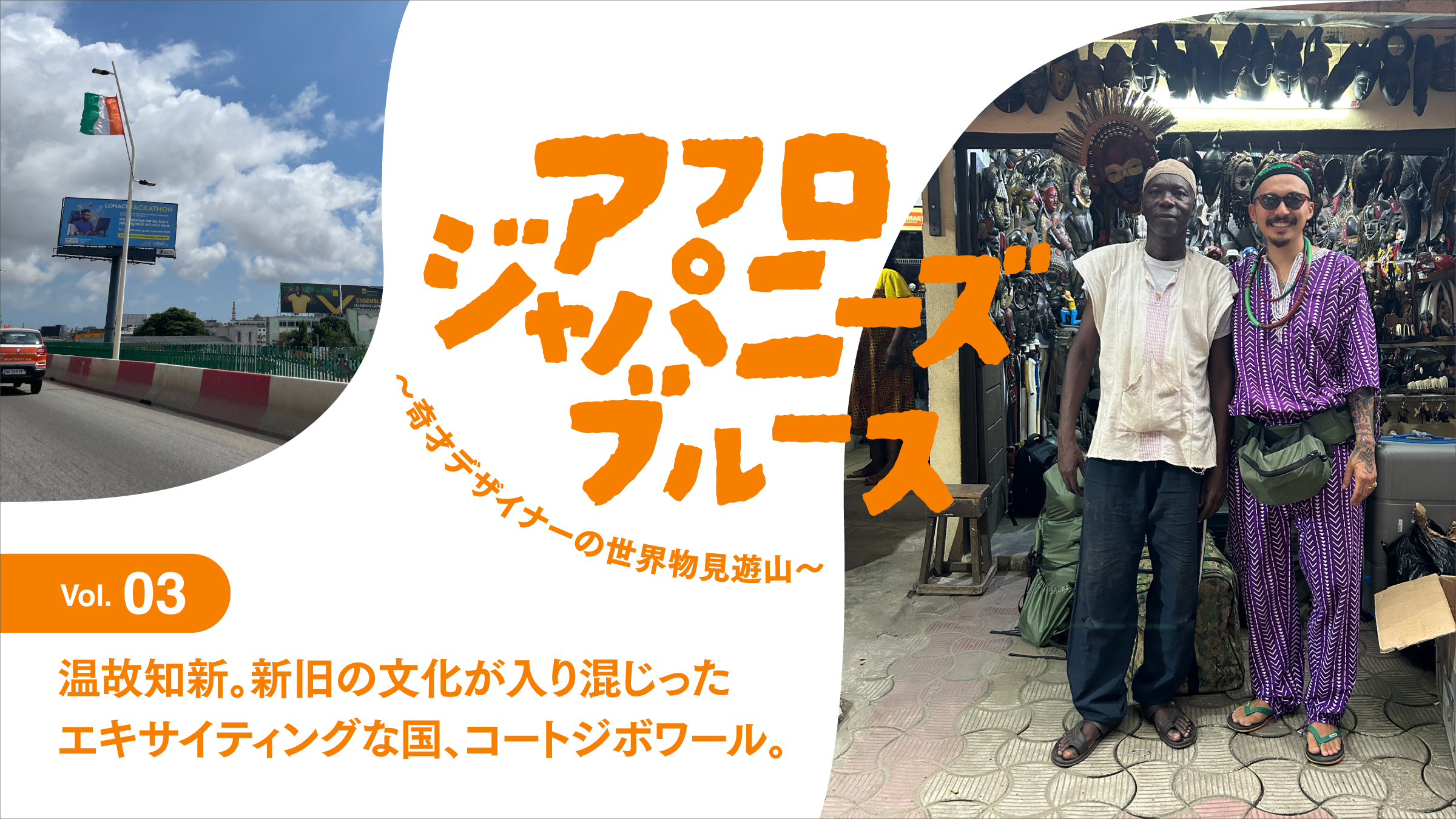Fascinated by black culture and passion forLamrofand an African jewelry label calledAFLOGICAL JEWELRYSDaisuke Sakamoto, aka Shirley, is a fashion designer who pours generously into the "Shirley" brand.
In addition, in recent years, the company has been developing a new label, "Miscellaneous Goods," which focuses on items from the American mid-century period, which it had been operating for some time.EARTHY ANTIQUESHe has also changed the direction of his business to mainly African goods, expressing the black culture he loves from various angles.
The term "Afro-zero" means "of African origin. In this sense, Sakamoto is an "Afro-Japanese" with roots in Africa, even though he is Japanese.
In this series, we introduce the people, things, and things that Mr. Sakamoto has seen while wandering around the world, especially in Africa, through his own filter. We present the realities of black culture as he sees it, how he incorporates it into his products, and the realities of the black culture that has fascinated him, through actual photos and Sakamoto's own voice.
Photo_Sha-Le (Daisuke Sakamoto)
Edit_Naoya Tsuneshige
PROFILE
In 2022, he launched the fashion brand "Ramroff". In 2024, he started an African jewelry label "AFLOGICAL JEWELRYS" and an antique goods label "EARTHY ANTIQUES". EARTHY ANTIQUES label will also be launched in 2024. He is deeply devoted to black culture and struggles daily to bring it to as many people as possible. He is also a soccer fan from the bottom of his heart.
Sha-Le Instagram:@8_shale_8
Lamrof Instagram:@lamrof_official
Aflogical Jewelrys Instagram:@aflogical_jewelrys
EARTHY ANTIQUES Instagram:@earthy_antiques
Difficulties unique to a country you are visiting for the first time.
After an intense 2-week stay in Senegal, Mr. Sakamoto next headed to Cote d'Ivoire without a moment to catch his breath. He arrived at the Felix Oufe-Boissani International Airport in Abidjan, the largest city in Cote d'Ivoire, about four hours away.
When I arrived here, I couldn't help but say this first: "Didier Drogba, thank you so much for bringing peace to Cote d'Ivoire. If you like soccer, you will understand, right? (Laughs)"
There are more than 60 traditional tribes in Cote d'Ivoire, and many of their folk crafts are appreciated worldwide. I have always wanted to visit one day, and I finally made it happen.
Surprisingly, the city of Abidjan is quite urban. I was first surprised by that. I was so surprised at how many skyscrapers and well-maintained roads there are that one might wonder, "Is this really Africa? I had never seen such a beautiful place in Africa, where off-roading is the default. I had never seen such a beautiful place in Africa, where off-roading is the default.
So far, it was still early in the morning. The sun had not yet risen at dawn in Cote d'Ivoire, and even though he was unfamiliar with the country, Mr. Sakamoto immediately proceeded with his research by demonstrating his signature communicative skills.
I injected myself with a strong espresso to wake me up. I talked to a local who happened to be sitting next to me at the café and asked him about the city of Abidjan. I got some information about a market where many dealers gather, so I decided to go there immediately.
As a result, it was a disappointment. Yes, there were some typical Ivory Coast items, but I had a feeling that tourists would gather here, so I took a quick look around for an hour or so and called it a day.
Mr. Sakamoto says that he felt keenly the difficulty of buying in a country he was visiting for the first time. He says there was a reason for this.
The time and things I seek are only valuable if I can build relationships with local people. In Senegal, I relied on the connections I already had and expanded them from there. We started by building relationships, and this timing made us realize once again that we were in a new country, and we were very enthusiastic about it.
Meeting a nice young man.
Second day in Abidjan. Mr. Sakamoto says he moved around a lot in order to visit all the major areas of Abidjan at once. He also had his own unique trip awaiting him.
I wanted to go around the cultural areas as well as the buying," he said, "so I moved around like a string of beads, being introduced to the next place after each one I visited. At times like this, I am always glad to have a distinctive look. It is easy to be interesting and interesting everywhere in Africa. So, when it comes to building relationships for information gathering, it is relatively easy to proceed.
My rule for gathering information is not to use the Internet. Basically, I trust only the information I gather on the street. Because I have a limited amount of time to visit places I know nothing about, sometimes I need to make a certain level of separation.
It is better to be able to go around with the help of real voices than to research a lot on the Internet and regret that you couldn't visit all of them. I feel like I am not lying to myself. That's why I value dialogue with local people very much.
Sakamoto was convinced of something on the second day of his stay.
The people of Cote d'Ivoire are really kind. When I told them I was looking for something, some of them stayed with me for hours until I found it. Then they exchanged contact information and said, 'Call me again if you need anything else! He never asked for a tip. And he never asked for a tip. This is very rare in Africa.
Mr. Sakamoto was touched by the warmth of the people of Cote d'Ivoire. He also shared an episode with a young man.
'I'm hungry, but I don't know where to eat. I asked a group of people who were huddled outside the market, 'I'm looking for some traditional food around here, do you have any recommendations? I asked one young man with a friendly smile. One of the young men said, "Follow me," with a kind smile.
I took him at his word and he introduced me to a "local" restaurant that I probably would not have found on my own, where I was served a traditional dish called "acequé. He gave me a lecture on how to eat it, waited until I was finished, and even bought me tissues to wipe my hands afterwards.
I asked, "Why do you do that much for me?" He replied, "It's normal because we are friends. I wanted to return the favor and told him to come to Japan someday, but he said, "I don't know about that. I don't know about that. My family is here. It was very chic and left a very strong impression on me. I felt again what a wonderful people they are, and I was really gripped by the country of Cote d'Ivoire.
We also stopped by a museum on the outskirts of Abidjan. I really like the space and the exhibits. In addition to antique traditional folk art, there is perhaps a strong contemporary art scene.
After moving around for a day, I felt that Abidjan is an interesting city with a mixture of old and new art. Some areas are deep and African, while others are clean, neat, and urban. Abidjan is a city that shows you a new look just by moving around a little. It's interesting."
The style of travel has come on board.
Mr. Sakamoto started his purchasing on the third day of his stay. It seems that he had many encounters.
Thanks to the fact that we had moved around Abidjan the day before, we had a clear idea of the markets we needed to visit that day. Since we had limited time to move around, it was really important for me to do my homework based on firsthand experience.
I was able to find original chevron bead accessories that I had been looking for for a long time in Senegal but could not find. We were able to procure them at a lower price than we had planned to ask for them in Senegal, even though they were of perfect quality. The reason was that the distance from Cameroon, the country of origin, was closer to Cote d'Ivoire. This was a happy miscalculation."
Accessories created with chevron beads actually purchased by Sakamoto, available at AFLOGICAL JEWELRYS.
The buying process, where Sakamoto says he had the best encounters. But this was not the only purpose of Sakamoto's trip, as he was also researching for his own fashion brand, "Ramlov.
Whenever I visit a country, I always try to input some of Ramrov's design ideas. In that sense, there were many more interesting ethnic costumes in Cote d'Ivoire than I had imagined, and there were many elaborate details and things that gave me a sense of identity, so I bought every single one of them as samples.
I especially liked the Senufo tribal costume made of Bogolan fabric. I couldn't resist the design around the sleeves."
Finally, Mr. Sakamoto shared this aside with us.
I am a pure Japanese, but in Cote d'Ivoire, I am not Japanese, I am Americano! Brazilian! I was often mistaken for a Colombiano! I was often mistaken for a "Columbiano! Once I stopped wearing dreads, for some reason, people started to think I was South American (laughs). I don't feel bad about it.
When I show them pictures of me with dreadlocks, they all say, "Why did you cut them off, what a waste! When I show them a picture of me with dreadlocks, they all say, "Why did you cut them off, what a waste! (Laughs.) I regretted it when that happened.... I shaved my head because the Japanese climate makes it hard to do so, but I wish I hadn't cut it (laughs).
Sakamoto in 2023, when he still had dreadlocks.
In the next issue, he will leave Abidjan and travel across Ivory Coast to Yamoussoukro and Bouaké, the capital city with a large Baule population, and Korgo, a city on the border with Burkina Faso with a large Senufo population. Look forward to the next installment of "Afro-Japanese Blues!
Sha-Le:@8_shale_8
Lamrof:@lamrof_official
Aflogical Jewelrys:@aflogical_jewelrys
EARTHY ANTIQUES:@earthy_antiques










